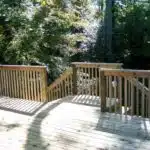Deck painting can be a daunting task for many homeowners. However, with the right tools and knowledge, it is possible to complete a DIY deck painting project without having to hire professional help. Painting your deck can give it a fresh new look while also protecting it from weather damage and wear and tear.
In this article, we will provide you with an easy guide to DIY deck painting. We will cover everything from prepping your deck for painting to choosing the right paint and tools for the job. By following these steps, you’ll be able to transform your old worn-out deck into a beautiful outdoor living space that you can enjoy for years to come. So grab your paintbrushes, put on some DIY clothes, and let’s get started!
Assessing The Condition Of Your Deck
Your deck is an extension of your home and a place where you can relax and enjoy the outdoors. However, over time, decks can deteriorate due to weather elements and constant use. Before you begin any painting project, it is essential to assess the condition of your deck. This step will help you determine if your deck requires minor repairs or a complete overhaul.
The first thing to consider when assessing your deck’s condition is its age. If your deck has been around for many years, it may have undergone substantial wear and tear that needs immediate attention. Check for loose boards, splinters, or protruding nails that could pose a safety hazard to you or your family.
Additionally, inspecting for rot is another crucial factor in determining the state of your deck. Rot can be challenging to detect and often goes unnoticed until it’s too late. Look out for soft spots on the surface of your deck or areas that seem spongy underfoot as they are clear indications of rotting wood. Once you’ve assessed these factors, move on to cleaning and prepping your deck for painting in the next section.
Cleaning And Prepping Your Deck
To ensure a successful deck painting project, it is crucial to start with a clean and prepped surface. Deck maintenance is an essential part of this process, as regular cleaning prevents dirt, grime, and mildew from building up on your deck’s surface. It is recommended that you power wash your deck at least once a year to remove any accumulated debris.
Power washing is an excellent way to clean your deck quickly and effectively. However, it can be dangerous if not done correctly. Before power washing your deck, make sure to wear protective gear such as goggles and gloves to avoid injury. Additionally, you should test the pressure washer’s strength on an inconspicuous area of the deck to ensure it won’t damage the wood.
Once you have completed the power washing process, allow your deck to dry for at least 24 hours before proceeding with any painting or staining. This will give the wood ample time to dry completely and ensure that no moisture remains in the wood, which could cause problems later on.
To summarize:
- Regular deck maintenance is key to ensuring a smooth painting project.
- Power washing can be an effective way to clean your deck but must be done safely.
- Allow ample time for your deck to dry completely before proceeding with any painting or staining.
With a clean and prepped surface, you’re now ready to move onto removing old paint or stain from your deck.
Removing Old Paint Or Stain
As you prepare to paint your deck, it is important to remove any old paint or stain that may be present. This step ensures that the new paint will adhere correctly and last longer. One way to remove old paint is by using chemical strippers. These strippers are applied to the surface of the deck and left for a period before being scraped off with a putty knife.
Another option for removing old paint or stain is through power washing. A power washer uses high-pressure water to blast away any old paint or stain, leaving behind a clean surface. However, it is important to use caution when power washing as too much pressure can damage your deck’s wood.
After using either chemical strippers or power washing, it is recommended to use a scraper to remove any remaining bits of old paint or stain. This will ensure that the surface of your deck is completely clean and ready for painting. Once this step is complete, you can move on to sanding your deck in preparation for painting.
By removing old paint or stain from your deck using chemical strippers, power washing and scraping techniques, you are ensuring that your new coat of paint will have a solid foundation to adhere to. Taking these necessary steps will also help prolong the life of your newly painted deck. Now that the old coat has been removed, let’s move on to sanding your deck in order to create an even surface for painting.
Sanding Your Deck
After removing the old paint or stain from your deck, the next step is to sand the surface. Sanding is crucial to achieving a smooth and even surface for painting. Deck sanding tips include using a random orbital sander and starting with a coarse grit sandpaper before gradually moving to finer grits. It’s also important to sand in the direction of the wood grain to avoid damaging the wood fibers.
Choosing sandpaper grits depends on the condition of your deck’s surface. If there are rough spots or peeling paint, start with a 40-60 grit sandpaper. Then, move onto an 80-100 grit paper for smoothing out any remaining rough areas and creating a uniform texture. Finally, finish with a 120-150 grit paper for a smooth finish that’s ready for painting.
Properly sanding your deck can be time-consuming but it’s essential for achieving professional-looking results. Remember to wear protective gear such as goggles and masks when sanding to avoid inhaling dust particles. Once you’ve finished sanding, inspect your deck closely for any damage or signs of wear and tear before repairing any issues in preparation for painting.
Repairing Any Damage
Assessing damage is the first step towards repairing your deck. Before you begin painting, take a thorough look at your deck and identify any damage that needs to be repaired. Look out for cracks, splinters, or rotting wood. These are all issues that can compromise the structural integrity of your deck and need immediate attention.
Once you’ve identified the areas that need repair, you can begin implementing the appropriate repair techniques. For minor cracks and splinters, sanding and filling with epoxy putty is often sufficient. For more severe damage like rotting wood, it may be necessary to replace entire boards or even sections of your deck. It’s essential to ensure that all repairs are carried out thoroughly before proceeding with painting.
Remember, if you’re not comfortable with assessing or repairing your deck yourself, it’s always best to consult a professional. A damaged deck is not only unsightly but also poses a safety hazard to anyone using it. Take the time to assess and repair any damage before proceeding with painting for a safe and long-lasting outcome.
As we move forward in this guide, we’ll discuss choosing the right paint or stain for your newly repaired deck. Remember that repairing any damage is an essential first step towards having a beautiful-looking deck!
Choosing The Right Paint Or Stain
- When selecting a paint or stain for a deck surface, it is important to consider the type of material used and the environmental conditions to determine the most appropriate product.
- Preparation of the deck surface is essential for a successful paint or stain project; this includes cleaning, sanding and priming the surface to ensure a smooth, long-lasting finish.
- There are a variety of paints and stains available for deck surfaces, from oil-based products to water-based acrylics and latex finishes.
- An additional consideration is the color and sheen desired; gloss paints provide a more durable finish, while flat or satin paints can help hide imperfections.
Types Of Paint Or Stain
When it comes to choosing the right paint or stain for your deck, there are several factors to consider. One of the most important is whether you want a water-based or oil-based product. Water-based paints and stains are easier to clean up with soap and water, dry faster, and emit fewer fumes than oil-based products. On the other hand, oil-based paints and stains tend to be more durable and provide better protection against moisture.
Another factor to consider when choosing a paint or stain for your deck is the finish you want. Matte finishes are more subtle and blend in with natural surroundings, while glossy finishes provide a bold and shiny look that can make your deck stand out. The choice between matte and glossy ultimately depends on personal preference, but keep in mind that glossier finishes tend to show imperfections more easily.
Ultimately, the type of paint or stain you choose for your deck will depend on a variety of factors including climate, usage patterns, and personal taste. Consider consulting with a professional painter or home improvement expert if you need help making a decision. With careful consideration and attention to detail, however, you can achieve a beautiful DIY deck painting job that will last for years to come.
Preparing The Deck Surface
When it comes to deck painting, choosing the right paint or stain is just one aspect of the process. Preparing the deck surface is equally important and requires careful consideration. Before painting or staining your deck, you must first clean and prepare the surface to ensure that the finish adheres properly.
Deck cleaning is an essential step in preparing your deck for painting or staining. Over time, dirt, grime, and even mildew can accumulate on your deck’s surface, affecting its appearance and compromising the integrity of any paint or stain you apply. To clean your deck, start by sweeping away any loose debris. Then use a power washer or hose with a high-pressure nozzle to remove any remaining dirt and debris.
Once your deck is clean, it’s time to prepare the surface for painting or staining. This involves sanding down any rough spots or splinters on the wood to create a smooth surface that will hold paint or stain evenly. It’s also important to fill in any cracks or holes with wood filler before applying paint or stain. Taking these steps will help ensure that your paint or stain adheres properly and lasts longer, giving you a beautiful DIY deck that you can enjoy for years to come.
Selecting The Proper Tools And Equipment
Now that you have chosen the right paint or stain for your deck, it’s time to select the proper tools and equipment. One of the most important decisions you will make is whether to use a brush or a roller. While both have their advantages and disadvantages, choosing the right one for your specific project can make a big difference in the outcome.
A comparison of brushes vs. rollers shows that brushes are best for intricate areas such as railings and spindles. They are also great for trim work and detail painting. Rollers, on the other hand, are best for large flat surfaces such as your deck’s flooring area. They can cover large areas quickly and evenly, making them ideal for covering large expanses of decking.
It is also important to invest in protective gear when painting your deck. You should wear gloves, goggles, and a mask to protect yourself from paint fumes and splatters. Additionally, wearing old clothes or an apron can help prevent paint stains from ruining your clothing. With these tools and protective gear in place, you’ll be ready to start applying primer to your deck in no time!
Applying Primer To Your Deck
Picture this: you’ve got all the tools ready for your deck painting project, but you’re not sure if applying primer is necessary. Well, let me tell you that primer is a must-have for any deck painting job. Not only does it provide a smooth surface for paint to adhere to, but it also protects your deck from weather damage and extends the life of your paint job.
The benefits of primer are numerous. Firstly, it creates a barrier between the wood and the elements, preventing moisture from seeping in and causing rot or decay. Secondly, it helps fill in any cracks or imperfections on the surface of your deck, resulting in a smoother finish once painted. Finally, using primer can help save time and money in the long run by reducing the amount of paint needed and extending its lifespan.
Some may argue that alternatives to primer exist, such as using a combination paint-and-primer product or skipping this step altogether. However, I strongly advise against these options as they do not provide the same level of protection and durability as using traditional primer. Investing in quality primer may seem like an additional expense at first but will ultimately save you time and money by ensuring your paint job lasts longer.
Now that you understand the importance of applying primer to your deck before painting it, let’s move on to the next step: actually painting your deck. But before we dive into that process, make sure to gather all necessary tools and materials so that you have everything ready when it’s time to start.
Painting Your Deck
- Prior to painting your deck, it is essential to thoroughly prepare the surface by cleaning, sanding, and repairing any damaged areas.
- When selecting paint and supplies, it is important to consider the type of material the deck is made from, as well as the desired finish.
- For decking made from wood, water-based paints are often recommended for a more durable result.
- To ensure proper coverage and protection, multiple coats of paint should be applied, allowing adequate drying time between each layer.
Preparing The Deck
Deck cleaning and sanding are crucial steps in preparing your deck for painting. Before you start, ensure that the surface is dry and free from debris. Clean the deck with a deck cleaner to remove dirt, grime, and stains. Use a stiff brush or pressure washer to scrub the surface thoroughly. Ensure all trapped dirt and grime are removed from between cracks and crevices.
Next, sanding the deck will help prepare it for painting by removing any rough spots or splinters. Sanding also helps to open up the pores of the wood, which allows paint to adhere better. Start by using coarse grit sandpaper then switch to finer grits as needed until you achieve a smooth surface. Pay particular attention to high traffic areas such as stairs and railings.
Lastly, make sure you protect yourself while carrying out these activities by wearing protective clothing such as gloves, goggles, and masks. In addition, be careful not to damage surrounding plants or furniture during cleaning and sanding processes. A well-prepared deck will not only look good but will also last longer when painted correctly.
Choosing Paint And Supplies
After cleaning and sanding your deck, the next step is choosing the right paint and supplies for your project. Selecting the right paint color and finish is crucial as it can affect the overall look and durability of your deck. When choosing a paint color, consider the style of your home and outdoor space. Neutral colors like gray, beige, or white are popular choices as they complement a variety of styles. However, if you want to add some personality to your deck, you can opt for bolder colors like blue or green.
When it comes to selecting a paint finish for your deck, you have several options to choose from. Glossy finishes are durable and easy to clean but tend to highlight imperfections in the wood. Satin finishes offer a more subtle shine that can hide defects in the wood while still being easy to clean. Matte finishes offer a more natural look that can help highlight the texture of the wood but may not be as durable as glossy or satin finishes.
Before starting your painting project, ensure that you have all necessary supplies on hand such as brushes, rollers, painters’ tape, and drop cloths. Choose high-quality products that are specifically designed for outdoor use to ensure long-lasting results. Taking time to carefully choose the right paint color and finish as well as investing in quality supplies will help ensure that your deck looks great for years to come while also increasing its durability against outdoor elements.
Staining Your Deck
Once you have successfully painted your deck, it’s time to consider staining. Staining will help protect the wood from weathering and UV damage while also enhancing its natural beauty. Choosing colors is an important part of this process as it can affect the overall aesthetic of your outdoor space.
When selecting a stain color, consider the color scheme of your home’s exterior and any surrounding landscaping. Lighter stains can create a more open and airy feel while darker stains provide a more dramatic contrast. Techniques for a smooth finish include using long even strokes with a brush or roller and evenly spreading the stain across the entire surface. Allow ample time for drying before walking or placing furniture on the newly stained deck.
To ensure proper coverage, apply at least two coats of stain with adequate drying time in between each coat. Additionally, applying a sealant or top coat will further protect your deck from moisture and UV rays. It is recommended to reapply both stain and sealant every 2-3 years to maintain optimal protection and appearance.
By following these simple steps, you can easily achieve a beautiful stained deck that enhances your outdoor living space for years to come.
Adding A Sealant Or Top Coat
After completing the painting process, it is crucial to add a sealant or top coat to ensure that your deck remains protected from external elements such as moisture, UV rays, and foot traffic. A sealant acts as an additional protective layer that helps to prevent water penetration and damage caused by weathering. There are different types of sealants available in the market, and each has its unique properties that make them suitable for specific situations.
When selecting a sealant type, consider factors such as durability, ease of application, drying time, color options, and compatibility with the paint used. Some common types of sealants include oil-based polyurethane, acrylic-based sealers, and waterproof coatings. Oil-based polyurethane is highly durable and resistant to abrasion but takes longer to dry than other types of sealants. Acrylic-based sealers are easy to apply and dry quickly but require frequent reapplication. Waterproof coatings provide the most robust protection but can be challenging to remove if you need to reapply paint in the future.
Application techniques also play a significant role in achieving an even coat of the sealant on your deck surface. Start by cleaning your deck thoroughly using mild detergent and water before applying the first coat of the sealer using a brush or roller. Ensure that you follow the manufacturer’s instructions regarding drying times between coats for optimal results. You may need to apply several layers depending on your selected sealer type and desired level of protection.
In preparing for maintaining your newly painted deck, remember that adding a topcoat or sealant is not only essential for protecting your deck but also enhances its overall appearance. By choosing the right type of sealer and following proper application techniques, you can achieve an excellent finish that will last for years with minimal maintenance required.
Maintaining Your Newly Painted Deck
Adding a sealant or top coat to your newly painted deck is an essential step in ensuring that it remains beautiful and protected for years to come. Did you know that a properly sealed deck can last up to 10 years without needing a complete repaint? That’s why it’s important not to skip this vital step.
Tips for preventing deck damage:
- Sweep regularly: Dirt, leaves, and other debris can trap moisture, leading to rot and decay.
- Trim nearby foliage: Overhanging branches can drop debris onto the deck and trap moisture.
- Use furniture pads: Heavy furniture can scratch the surface of your new paint job.
Regular maintenance is crucial in extending the life of your freshly painted deck. Neglecting it can lead to costly repairs down the road. Here are some reasons why regular maintenance is important:
- Prevents rot and decay caused by trapped moisture
- Protects against sun damage, which causes fading, chalking, and cracking
- Helps identify issues early on before they become more severe
Incorporating preventative measures into your routine maintenance will ensure that your deck stays beautiful and functional for years to come. However, even with regular upkeep, troubleshooting common issues may still arise. In the next section, we’ll cover some tips for addressing these problems head-on.
Troubleshooting Common Issues
Common Issues in DIY Deck Painting
While painting your deck can be an exciting DIY project, it is not always smooth sailing. Common issues can arise during the process that may hinder the outcome of your project. In this section, we’ll discuss some common problems and their possible solutions, as well as prevention techniques to ensure a successful paint job.
One of the most common issues homeowners face when painting their deck is peeling or chipping paint. This problem usually occurs when there is poor adhesion between the paint and the surface of the deck. To prevent this issue, make sure to thoroughly clean and dry your deck before applying any paint. Also, use a quality primer to create a strong bond between the surface and paint. If peeling or chipping does occur, remove all loose paint with sandpaper or a pressure washer, then reapply primer and repaint.
Another common problem is blistering or bubbling of the paint after application. This issue can happen due to moisture trapped beneath the surface or too much heat during application. To avoid this problem, make sure your deck is completely dry before painting and avoid painting on hot days. If blistering does occur, wait for the surface to dry completely before lightly sanding and repainting.
| Common Solutions | Prevention Techniques |
|---|---|
| Peeling/chipping paint | Thoroughly clean/dry deck before painting; Use quality primer; Remove loose paint and repaint |
| Blistering/bubbling | Ensure deck is completely dry before painting; Avoid hot days; Wait for surface to dry completely if blistering occurs |
Lastly, another issue that may arise during DIY deck painting is uneven color or texture after drying. This problem can happen due to improper mixing of paints or inadequate coverage during application. To prevent this issue, make sure you mix your paints thoroughly before starting and apply enough coats for full coverage without overdoing it. If uneven color or texture does occur, consider applying an extra coat of paint to even out the finish.
By understanding these common issues and implementing prevention techniques, you can avoid potential problems during your DIY deck painting project. In the next section, we’ll provide tips and tricks to ensure a successful outcome for your project.
Tips And Tricks For A Successful Diy Deck Painting Project
Achieving a successful DIY deck painting project requires careful planning and execution. In this section, we will share some tips and tricks to help you achieve the best results possible. One important aspect is color coordination. When choosing colors for your deck, consider the exterior of your home to ensure that the colors complement each other. This can enhance your home’s curb appeal and create a cohesive look.
Another factor to consider is budget-friendly options for deck painting. There are many cost-effective paints on the market that can provide excellent results without breaking the bank. Look for paint brands that offer good coverage and durability, even if they are not the most expensive option available.
Before starting your DIY deck painting project, make sure you have all the necessary tools and equipment on hand. This includes sandpaper, primer, paint brushes or rollers, and masking tape for protecting areas you don’t want painted. Proper preparation is key to achieving a smooth and long-lasting finish.
Next, we will move on to frequently asked questions (FAQs) about deck painting. These questions cover common concerns such as how often to paint your deck, how to prepare it for painting, and how to avoid common mistakes when applying paint. By following these tips and tricks along with answering some of these FAQs, you can successfully complete a DIY deck painting project that adds beauty and value to your home while also reflecting your personal style.
Frequently Asked Questions (Faqs) About Deck Painting
Frequently Asked Questions (FAQs) about Deck Painting
Painting your deck can be a challenging DIY project, but it is also a great way to improve the look and functionality of your outdoor space. However, as with any home improvement project, there are common mistakes that you should avoid. In this section, we will address some frequently asked questions about deck painting and provide tips for avoiding these mistakes.
Q: What are some common DIY deck painting challenges? A: One challenge that many homeowners face when painting their decks is ensuring that the paint adheres properly. This can be difficult if the surface of your deck is not properly cleaned or if there are any existing coatings on the wood. Another challenge is ensuring that the paint is applied evenly and without drips or brush marks.
Q: What are some common mistakes to avoid when painting a deck? A: One common mistake is using the wrong type of paint. It’s important to use a paint specifically designed for outdoor use and for use on wood surfaces. Another mistake is failing to properly prepare the surface before painting. This includes cleaning and sanding the wood to ensure proper adhesion of the paint. Additionally, applying too thick of a coat can lead to peeling or cracking in the future.
- Don’t rush through preparation – take time to clean and sand the surface
- Use high-quality tools and materials for best results
- Apply thin coats of paint instead of thick layers
- Consider using a primer before applying paint
- Avoid painting in direct sunlight or extreme temperatures
Overall, while deck painting may seem daunting at first, with proper preparation and attention to detail, it can become an enjoyable DIY project with great results. By avoiding common mistakes such as using improper paints or failing to prepare your surfaces properly, you can ensure that your new painted deck will look beautiful for years to come.
Conclusion
In conclusion, painting your deck can be a daunting task, but with the right preparation and technique, it can be a rewarding DIY project. Remember to assess the condition of your deck and thoroughly clean and prep it before applying any paint or stain. If you encounter any issues such as peeling or cracking paint, don’t hesitate to troubleshoot and repair as necessary.
As a DIY deck painting expert, I suggest taking advantage of the many tips and tricks available to make your project go smoothly. For example, consider using a paint sprayer for a more even finish, or adding texture with special additives. And don’t forget to maintain your newly painted deck by regularly cleaning and resealing it.
In the end, the effort you put into painting your deck will be well worth it when you have a beautiful outdoor space to enjoy with family and friends. So grab your tools and get started on transforming your old, worn-out deck into a stunning focal point of your home’s exterior.
Image Credits












![How To Build A Detached Deck 12 Force Reconnaissance Detachment Deck Shoot [Image 4 of 4]](https://green-life.blog/wp-content/uploads/2023/05/RJo3tlizSGjq-150x150.jpg.webp)
















